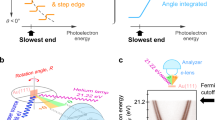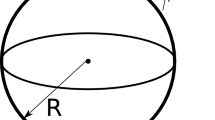Abstract
Although measurements of the polar dependence of the surface free energy are easily available, measurements of the whole polar dependence of the surface stress of a crystal do not exist. Here, we present a procedure that allows the experimental determination of this dependence. For this purpose, electromigration was used to control the kinetic faceting of surface orientations that belong to the equilibrium shape of the crystal, and for each destabilized surface, the period of faceting as well as the crystallographic angles of the appearing facets were measured by atomic force microscopy. The data obtained lead to a set of equations whose mathematical solution, compatible with physical constraints, gives access to the surface stress polar dependence of the whole crystal, and thus to a better understanding of surface stress properties.
This is a preview of subscription content, access via your institution
Access options
Subscribe to this journal
Receive 12 print issues and online access
$259.00 per year
only $21.58 per issue
Buy this article
- Purchase on Springer Link
- Instant access to full article PDF
Prices may be subject to local taxes which are calculated during checkout






Similar content being viewed by others
References
Sundquist, B. A direct determination of the anisotropy of the surface energy of solid Au, Cr, Ni, α-Fe. Acta. Metall. 12, 67–86 (1964).
Bermond, J. M., Métois, J. J., Egea X. & Floret F. The equilibrium shape of silicon. Surf. Sci. 330, 48–60 (1995).
Ibach, H. The role of surface stress in reconstruction, epitaxial growth and stabilization of mesoscopic structures. Surf. Sci. Rep. 29, 193–263 (1999).
Müller, P. & Saùl, A. Elastic effects on surface physics. Surf. Sci. Rep. 54, 157–258 (2004).
Bach, C., Giesen, M., Ibach, H. & Einstein, T. Stress relief in reconstruction. Phys. Rev. Lett. 78, 4225–4228 (1997).
Filipetti, A. & Fiorentini, V. Faceting and stress of missing-row reconstructed transition-metal (110) surfaces. Surf. Sci. 377, 112–116 (1997).
Olivier, S., Saúl, A. & Tréglia, G. Relation between surface stress and (1x2) reconstruction for (110) fcc transition metal surfaces. Appl. Surf. Sci. 212/213, 866–871 (2003).
Wynblatt, P. & Ku, R. Surface energy and solute strain energy effects in surface segregation. Surf. Sci. 65, 511–531 (1977).
Ibach, H. The relation between the strain-dependence of the heat of adsorption and the coverage dependence of the adsorption induced surface stress. Surf. Sci. 556, 71–77 (2004).
Berger, R. et al. Surface stress in the self-assembly of alkanethiols on gold. Science 276, 2021–2024 (1997).
Marchenko, V. Theory of the equilibrium shape of crystals. JETP 54, 605–607 (1981).
Alerhand, O. Vanderbilt, D., Meade, R. & Joannopoulos J. Spontaneous formation of stress domains on crystal surfaces. Phys. Rev. Lett. 61, 1973–1976 (1988).
Rousset, S. et al. Self-ordering on crystal surfaces: fundamentals and applications. Mater. Sci. Eng. B 96, 169–177 (2002).
Wulff, G. Zur frage der geschwindigkeit des wachsthums und der auflösung der krystallfläschen. Z. Kristall. 34, 449–480 (1901).
Herring, C. Some theorems on the free energies of crystal surfaces. Phys. Rev. 82, 87–93 (1951).
Rousset, S. et al. Self-organization on Au(111) vicinal surfaces and the role of surface stress. Surf. Sci. 422, 33–41 (1999).
Johnson, R. Construction of filaments surfaces. Phys. Rev. 54, 459–467 (1938).
Moore, A. Thermal Faceting in Metal Surfaces: Structure, Energetics and Kinetics 155 (American Society for Metals, Metals Park, Ohio, 1962).
Latyshev, A., Litvin L. & Aseev, A. Peculiarities of step bunching on Si(001) surface induced by DC heating. Appl. Surf. Sci. 130/132, 139–145 (1998).
Métois, J. J. & Stoyanov, S. Impact of the growth on the stability-instability transition at Si(111) during step bunching induced by electromigration. Surf. Sci. 440, 407–419 (1999).
Yagi, K., Minoda, H. & Degawa, M. Step bunching, step wandering and faceting self-organization at Silicon surfaces. Surf. Sci. Rep. 43, 45–126 (2001).
Jeong, H. & Williams, E. Steps on surfaces: experiment and theory. Surf. Sci. Rep. 34, 171–294 (1999).
Krug, J. & Dobbs, H. Current induced faceting of crystal surfaces. Phys. Rev. Lett. 73, 1947–1950 (1994).
Stewart, J. & Goldenfeld, N. Spinodal decomposition of a crystal surface. Phys. Rev. A 46, 6505–6512 (1992).
Liu, F. & Metiu, H. Dynamics of phase separation of crystal surfaces. Phys. Rev. B 48, 5808–5817 (1993).
Song, S., Mochrie, S. & Stephenson, S. Faceting kinetics of stepped Si(113) surfaces: a time-resolved X-ray scattering study. Phys. Rev. Lett. 74, 5240–5243 (1995).
Song, S., Yoon, M., Mochrie, S., Stephenson, G. & Milner, S. Faceting kinetics of stepped Si(113) surfaces: dynamic scaling and nanoscale growth. Surf. Sci. 372, 37–63 (1997).
Sander, D. & Ibach, H. in Physics of Covered Surfaces Vol. 42 (ed. Bonzel, H.) Ch. 4 (Landölt Bornstein New Series Group III, Springer, New York, 2002).
An, T., Yoshimura, M., Ono, I. & Ueda, K. Elemental structure on Si(110) 16x2 revealed by STM. Phys. Rev. B 61, 3006–3011 (2000).
Song, S., Yoon, M. & Mochrie, S. Faceting, tricriticality and attractive interactions between steps in the orientational phase diagram of silicon surfaces between [113] and [5512] Surf. Sci. 334, 153–169 (1995).
Acknowledgements
We acknowledge J. Fuhr, G. Tréglia, R. Kern and S. Olivier for helpful discussions and J. P. Astier for the AFM images.
Author information
Authors and Affiliations
Corresponding author
Ethics declarations
Competing interests
The authors declare no competing financial interests.
Rights and permissions
About this article
Cite this article
Métois, J., Saúl, A. & Müller, P. Measuring the surface stress polar dependence. Nature Mater 4, 238–242 (2005). https://doi.org/10.1038/nmat1328
Received:
Accepted:
Published:
Issue Date:
DOI: https://doi.org/10.1038/nmat1328
This article is cited by
-
Polar surface structure of oxide nanocrystals revealed with solid-state NMR spectroscopy
Nature Communications (2019)
-
Tunable Ultra-high Aspect Ratio Nanorod Architectures grown on Porous Substrate via Electromigration
Scientific Reports (2016)
-
Thermal surface free energy and stress of iron
Scientific Reports (2015)



